#akha fashion
Photo

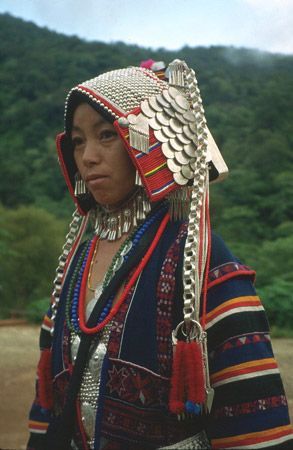
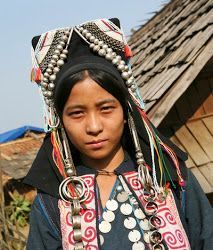

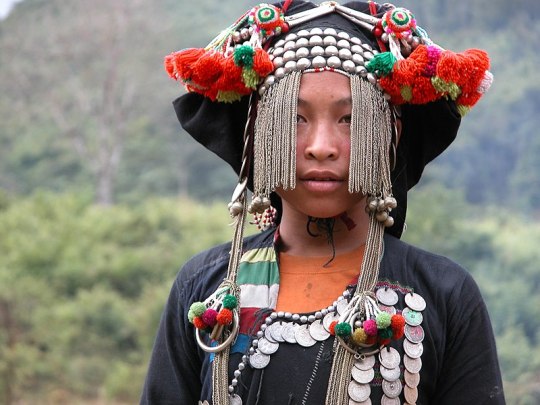
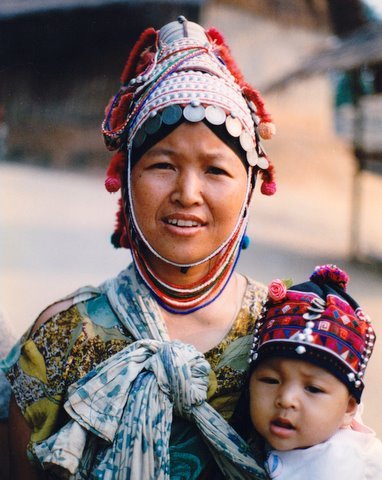
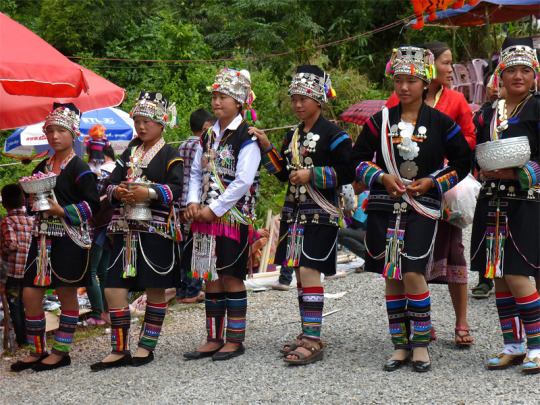
1. Akha hilltribe girl, Chiang Mai flower festival, Thailand by Steve Vidler
2. Pamee Akha woman with traditional headdress with silver coins, Thailand by Jim Goodman
3. Akha woman of Laos
4. Tachilek Akha
5. Akha girl in Laos
6. Akha woman and child, Thailand
7. That Xieng Tung Festival, Muang Sing, Laos. Akha young girls in the welcoming committee. On their arrival, visitors will have a color ribbon pinned to their blouse in exchange for a donation.
The Akha are an indigenous hill tribe who live in small villages at higher elevations in the mountains of Thailand, Myanmar, Laos, and Yunnan Province in China. They made their way from China into Southeast Asia during the early 20th century. Civil war in Burma and Laos resulted in an increased flow of Akha immigrants and there are now some 80,000 living in Thailand's northern provinces of Chiang Rai and Chiang Mai, where they constitute one of the largest of the hill tribes. Many of their villages can be visited by tourists on trekking tours from either of these cities.
Due to rapid social and economic changes in the regions the Akha inhabit, particularly the introduction of Western modes of capitalism, attempts to continue many of the traditional aspects of Akha life are increasingly difficult. Despite these challenges, Akha people practice many elements of their traditional culture with much success.
The Akha people are often noted for their very recognizable sartorial practices. Akha women spin cotton into thread with a hand spindle and weave it on a foot-treadle loom. The cloth is hand dyed with indigo. Women wear broad leggings, a short black skirt with a white beaded sporran, a loose fitting black jacket with heavily embroidered cuffs and lapels. Akha women are known for their embroidery skills. While traditional clothes are typically worn for special ceremonies, one is more likely to see Akha villagers in full traditional garb in areas that have heavy volumes of tourists, particularly in Thailand.
The headdresses worn by the women are perhaps the most spectacular and elaborate items of Akha dress. Akha women define their age or marital status with the style of headdress worn. At roughly age 12, the Akha female exchanges her child's cap for that of a girl. A few years later she will begin to don the jejaw, the beaded sash that hangs down the front of her skirt and keeps it from flying up in the breeze. During mid-adolescence she will start wearing the adult woman's headdress. Headdresses are decorated by their owner and each is unique. Silver coins, monkey fur, and dyed chicken feathers are just a few of the things that might decorate the headdress. The headdresses differ by subgroup.
According to an article about the variations in Akha headdress, "High Fashion, Hill Style", the
"Ulo Akha headdress consists of a bamboo cone, covered in beads, silver studs and seeds, edged in coins (silver rupees for the rich, baht for the poor) topped by several dangling chicken feather tassels and maybe a woolen pom-pom. The Pamee Akha wear a trapezoidal colt cap covered in silver studs with coins on the beaded side flaps and long chains of linked silver rings hanging down each side. The Lomi Akha wear a round cap covered in silver studs and framed by silver balls, coins and pendants and the married women attach a trapezoidal inscribed plate at the back."
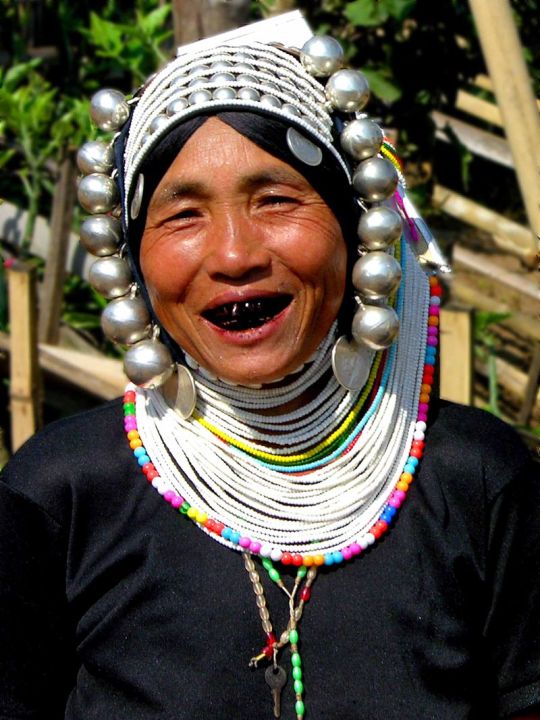
^Myanmar (Her teeth have been intentionally dyed black, a relatively common practice in parts of east and southeast Asia. The lacquer used prevents tooth decay.)
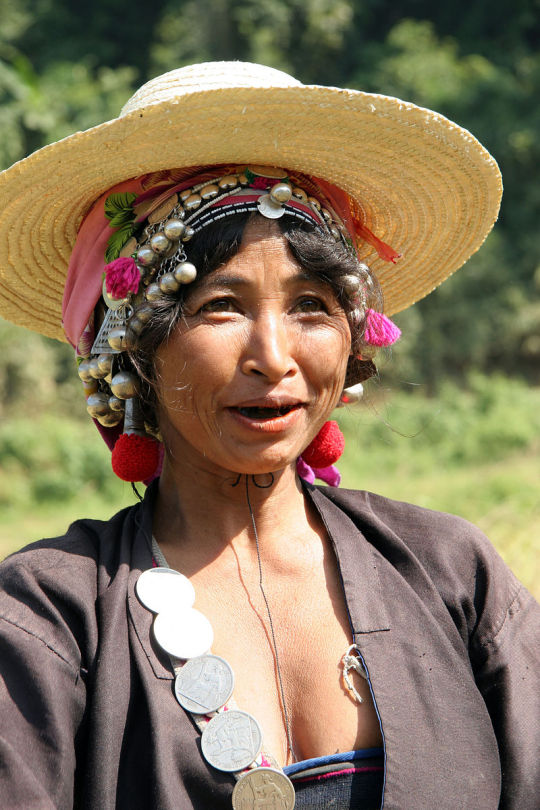
^Laos

^Laos
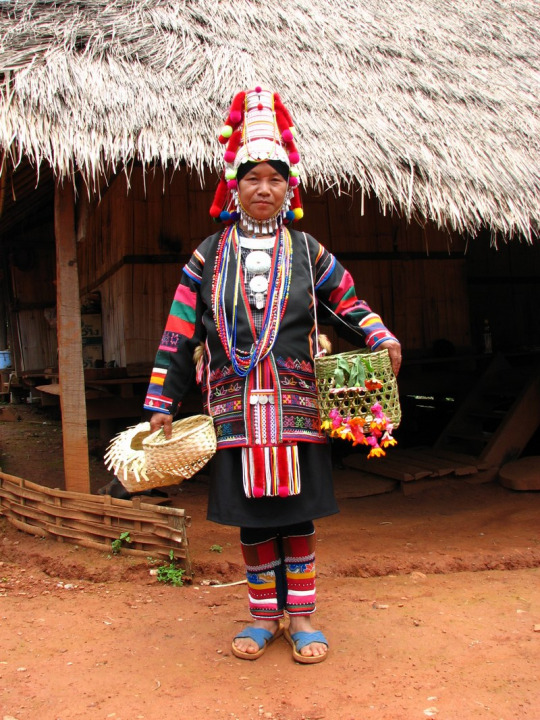
^Thailand
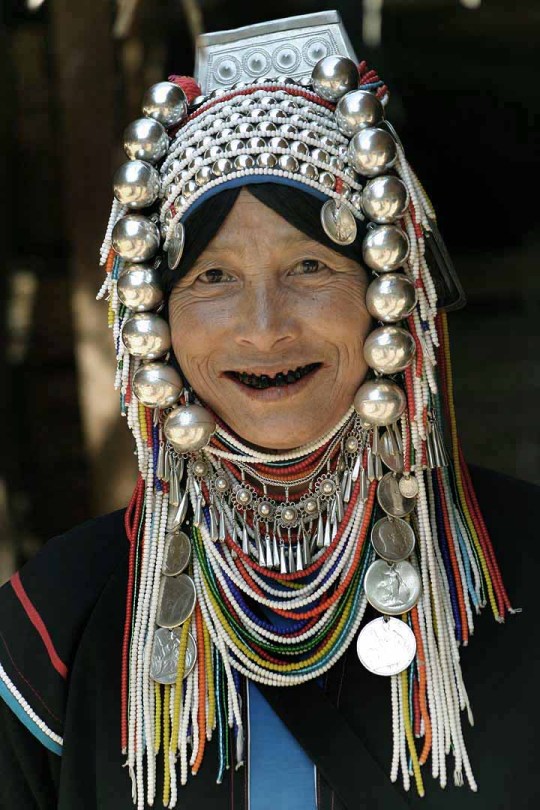
^Thailand
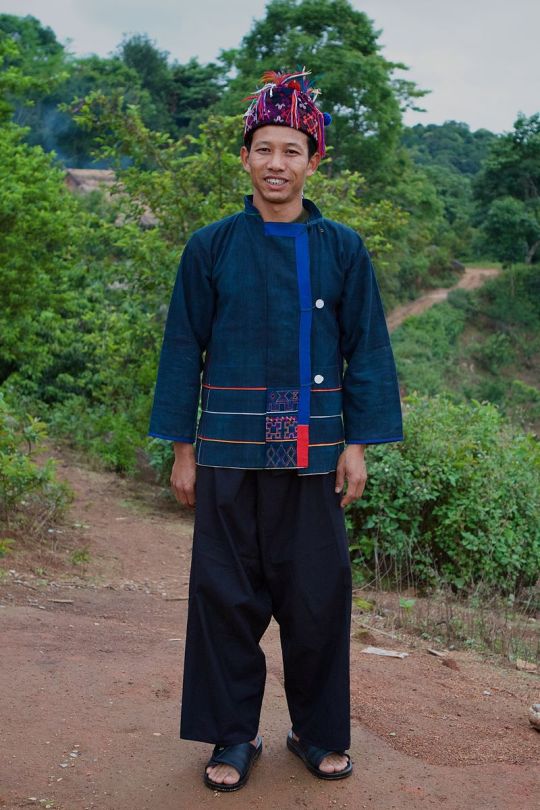
^ Ban Mae Chan Tai, Chiang Rai Province, Thailand
Akha society lacks a strict system of social class and is considered egalitarian. Respect is typically accorded with age and experience. Ties of patrilineal kinship and marriage alliance bind the Akha within and between communities. Village structures may vary widely from the strictly traditional to Westernized, depending on their proximity to modern towns. Like many of the hill tribes, the Akha build their villages at higher elevations in the mountains.
Akha dwellings are traditionally constructed of logs, bamboo, and thatch and are of two types: "low houses", built on the ground, and "high houses", built on stilts. The semi-nomadic Akha, at least those who have not been moved to permanent village sites, typically do not build their houses as permanent residences and will often move their villages. Some say that this gives the dwellings a deceptively fragile and flimsy appearance, although they are quite well-built as proved over generations.
Entrances to all Akha villages are fitted with a wooden gate adorned with elaborate carvings on both sides depicting imagery of men and women. It is known as a "spirit gate". It marks the division between the inside of the village, the domain of man and domesticated animals, and the outside, the realm of spirits and wildlife. The gates function to ward off evil spirits and to entice favorable ones. Carvings can be seen on the roofs of the villager's houses as a second measure to control the flow of spirits.
The traditional form of subsistence for the Akha people has been, and remains, agriculture. The Akha grow a variety of crops including soybeans and vegetables. Rice is the most significant crop and is prominent in much of Akha culture and ritual. Most Akha plant dry-land rice, which depends solely on rainfall for moisture, but in some villages irrigation has been built to water paddy fields. Historically, some Akha villages cultivated opium, but production diminished after the Thai government banned its cultivation.
The Akha have traditionally employed slash and burn agriculture, in which new fields are cleared by burning or cutting down forests and woodlands. In such a system, there is usually no market for land. Rights to land are considered traditional and established over many generations. This type of agriculture has contributed to the Akha's semi-nomadic status as villages move to clear new farmland with each successive burn cycle. The Thai government has forbidden this practice, citing its detrimental effects on the environment. The Akha have adapted to new types of subsistence farming, but the quality of their land has suffered as they are no longer allowed to expand onto new plots. In many cases, chemical fertilizers are the only option for re-fertilizing the land.
Akha religion — zahv — is often described as a mixture of animism and ancestor worship that emphasizes the Akha connection with the land and their place in the natural world and cycles. Although Akha beliefs and rituals involve all of these elements, the Akha often reject the casual categorization of their practices as such saying it simplifies and reduces its meaning. The Akha way emphasizes rituals in everyday life and stresses strong family ties. Akha ethnicity is closely tied to the Akha religion. It might be said that to be considered an Akha ethnically by other Akhas is to practice the Akha religion.
The Akha put a heavy emphasis on genealogy. An important tradition involves the recounting by Akha males of their patrilineal genealogy. During the most important ceremonies the list is recited in its entirety back over 50 generations to the first Akha, Sm Mi O. It is said that all Akha males should be able to do so. The recounting of this lineage plays a role in the incest taboo: If a male and female Akha find a common male ancestor within their last six generations, they are not allowed to marry.
Rights, issues, and activism
Being an ethnic minority with little easily accessible legal recourse, Akha everywhere have long been subject to rights abuses.
Perhaps the most important issue facing the Akha pertains to their land. The Akha relationship to land is vitally connected to the continuation of the Akha culture, but they rarely have "official" or state-sanctioned land rights or claims to their land as land rights are considered traditional. These conceptions of land are at odds with those held by the nation states whose land the Akha now occupy. Most Akha are not full-fledged citizens of the country they inhabit and are thus not allowed to legally purchase land, although most Akha villagers are too poor to even consider purchasing land.
It has been reported by rights groups that several land seizures of Akha land have been undertaken in the name of the Queen of Thailand. Originally a semi-nomadic people, the Akha are often relocated by the presiding national government to permanent villages, after which the government allegedly sells to logging companies and other private corporations access to lands formerly occupied by the Akha. The land onto which the Akha are displaced is almost always less fertile than their previous plots. On their new lands, the Akha can rarely produce enough food to sustain themselves and are often forced to leave and seek employment outside the villages, thus disrupting their traditional culture and economy.
In Thailand, laws have been passed that curb people's rights to the forest, including the 2007 Community Forest Act. According to the network of indigenous peoples in Thailand,
"These laws and resolutions have had severe impacts on indigenous peoples' rights to residence and land. Under these laws and resolutions millions of hectares of land have been declared as reserved and conservation forests, or protected areas. Today, 28.78% of Thailand is categorized as protected areas. As a result, thousands of farmers previously living in the forest or relying on the forest for their livelihood have been arrested and imprisoned and their lands seized. Cases have been filed against them for the so-called encroachment on government land."
Despite having signed and ratified the Convention on Biological Diversity, the Thai government has not changed laws to adhere to those recommendations emphasizing respect for the rights of indigenous peoples and their full and effective participation in protected areas management and policy-making.
The reasons given for Akha relocations vary, but a common response on the part of the Thai government is to cite a concern for the preservation of forests and the promotion of more sustainable agricultural techniques than the slash and burn agriculture traditionally used by the Akha.
Despite their numbers, the Akha are the poorest of all the hill tribes. As roads bring accessibility and tourists, they provide relief from the poverty of village life, especially for the younger generations who increasingly find themselves engaged in labor outside the villages. Many villages report a population decrease as many leave to find work in the cities, often for very long periods. Many Akha complain that the younger generations are becoming increasingly less interested in traditional culture and ways and more and more susceptible to outside, mainstream, cultural influences. According to one author, where the village squares were once "filled with the sounds of courtship songs", radios are now more likely to play pop hits.
As it becomes increasingly difficult to remain self-sufficient through agriculture, and as roads open up the villages to the cities, the Akha must contend with the sometimes corrosive effects of the tourist industry. Not all Akha are happy to let tourists come in and observe village life.
Many Akha complain of the missionaries that come to the villages to convert them, sometimes forcibly, to Christianity. Many Akha feel that the missionaries generalize about, or in this particular case, "paganize" the Akha traditional belief system, demeaning their longstanding beliefs. Some of the claims made against missionaries include the kidnapping of Akha children into orphanages and forced labor, the sterilization of Akha women and the forced or underpaid labor of Akha on farms. Many rights groups make the claim that the money spent by missionaries on building churches and furthering Christian education could be better spent on helping the Akha with medical and sanitation improvements that are greatly needed in most villages.
264 notes
·
View notes
Text

Akha girl, Laos, by Tim Draper
#akha#laos#asia#southeast asia#traditional fashion#folk clothing#traditional clothing#cultural clothing
391 notes
·
View notes
Photo

#akha people#akha#Laos#Lao#Lao minority#lao fashion#lao folk#lao costume#lao culture#lao attire#lao outfit#woman fashion#man fashion#southeast asia#asia#asian#asian folk costume#Asian fashion#Asian Folk#asian culture#asian costume#asian outfit#asian attire
69 notes
·
View notes
Photo

Why not start off the new year with a new hat? It’s doesn’t get any more amazing than this Akha Vintage Bamboo Headdress from the mid to late 20th century Northern Thailand. The Akha are closely related with the Hani of Yunnan province, China; the Akha-Hani community numbers about two to three million people, but with just over 70,000 members in Thai territory. The Akha Way combines animism, ancestor worship and their deep relationship with the land. For an Akha, the Akha Way is a way of life which extends beyond simple religious practice and infuses every aspect of their existence. The Akha Way emphasizes rituals in everyday life and stresses strong family ties. #akha #akhaheaddress #headdress #vintageheaddress #bambooheaddress #animism #ancestorworship #akhaway #thailand #northernthailand #statementheadpiece #vintageheadpiece #fashion #style #styleinspiration #shop #nyc #unionsquare #beadsofparadise (at Beads of Paradise NYC) https://www.instagram.com/p/BsJtY6vA64u/?utm_source=ig_tumblr_share&igshid=vyyjwvk3ql7g
#akha#akhaheaddress#headdress#vintageheaddress#bambooheaddress#animism#ancestorworship#akhaway#thailand#northernthailand#statementheadpiece#vintageheadpiece#fashion#style#styleinspiration#shop#nyc#unionsquare#beadsofparadise
0 notes
Photo

The Akha migrated from China to Laos, Myanmar, Thailand and Vietnam over the past 200 years. Some of their villages can be found today in the far north of Laos, primarily Phongsaly and Luang Namtha provinces. Traditionally living in more upland areas, some Akha communities can be very remote.
While they used to be also called the Ko or Iko, these names are now considered impolite. The Akha comprises many different sub-groups and clans, who have maintained very strong identities and lifestyles.
Though the Akha do not have a written script, men are able to recite their genealogy going back over 60 generations. This has helped to maintain the Akha identity and history that links clans and families.
Akha villages can be easily recognized by their gates and large swings. The gate is considered a marker between the human and spirit worlds. It is believed to protect the village from outlaws, wild animals and disease. Visitors should never touch it. The village swing is used during the harvest festival in August or September, a time of fun and celebration.
Akha women are famous for their silver headdresses that come in different shapes and designs, depending on the Akha group, and can be very expensive. The Akha Djepia, for instance, wear a cone-shaped headdress, while the Akha Pouly headdress is more rounded, with a flat disc at the back. The Akha also wear indigo-dyed cotton clothing, decorated with embroidery, applique-work and beads.
Photographer: Tim Draper
432 notes
·
View notes
Text
Data Objects 3 (TW)
Wednesday 27th March
My idea for this data object was to create a bracelet that represented the statistics of the working conditions of workers in the Bangalore garment industry. I had the idea to make the bracelet multicoloured a section representing the percentage of women who had experienced physical and sexual assault in the workplace and that i would make multiple to represent different percentages of data. (however my prototype is missing the different colours mainly because I had no other material sources, but if i were to make the product I would use dye and a thinner material.) I was inspired to make a bracelet as they are often used to express a stance or orientation towards something, people often wear bracelets in support of a foundation, band or for an event being held. Additionally, bracelets are common in many countries to be sold at markets and on the street. Coming from Thailand, bracelets are easy to make and also have a cultural significance to the Akha people, so is true in many other countries.
I had also been inspired by the following video, where SEQUENCE employs young men susceptible to the gang culture and violence that exists in El Salvador, to create bracelets that spread awareness and provide community for those men.
youtube
The data set I was focusing on:
Working conditions in the Bangalore garment industry [1]
Several recent reports have documented working conditions in the Bangalore garment industry. All workers except tailors are classified as unskilled, and typically work for low wages just at or below the statutory minimum wage. These wages have risen only marginally over a period of several years, failing to keep pace with the high rates of inflation in the IT metropolis of Bangalore. A joint report by the Dutch Clean Clothes Campaign, the India Committee of the Netherlands and Cividep India found that one-third of workers interviewed in garment factories earned less than the legal mini- mum wage for unskilled workers, even if they held semi-skilled or skilled positions. [2] Labourers work overtime hours to support their families, sometimes without the legally required compensation, and occasionally under threat of termination. Harassment by supervisors and floor managers is common, not least because of the low scope for women to rise to positions of authority on the shop- floor. A recent report by the UK organisation Sisters for Change found that over 60% of the female garment workers interviewed had been intimidated or threatened with violence. One in fourteen women had experienced physical violence, while a startling one in seven had been forced to commit a sexual act or forced to have sexual intercourse at work. In most of the cases of harassment and violence against women, supervisors and floor-in-charge managers are the perpetrators. [3]

Figure 1. bracelet prototype
References:
[1] Miedema, C. (2018, May 17). Labour Without Liberty - Female Migrant Workers in Bangalore's Garment Industry (full report). Retrieved from https://cleanclothes.org/resources/publications/labour-without-liberty-2013-female-migrant-workers-in-bangalores-garment-industry-full-version-1/view
[2] Doing Dutch – A research into the state of pay for workers in garment factories in India working for Dutch fashion brands (India Committee of the Netherlands, Sep 2016); source: http://www.indi- anet.nl/pdf/DoingDutch.pdf
[3] Eliminating violence against women at work (Sisters for Change & Munnade, Jun 2016); source: http://sistersforchange.org.uk/wp-content/uploads/2016/06/SFC_WomenatWork_FullReport_ 25June2016.pdf
3 notes
·
View notes
Photo

Y O U S H O U L D K N O W: T H E A K H A P E O P L E The Akha are an indigenous Hill tribe who live in small villages at higher elevations in the mountains of THAILAND, BURMA, LAOS, VIETNAM & YUNNAN Province in CHINA. They made their way from China into Southeast Asia during the early 1900s. Civil war in Burma & Laos resulted in an increased flow of Akha immigrants. The Akha speak Akha, a language from Lolo/Yi branch of the Tibeto-Burman family. Dwellings that are traditionally constructed of logs, bamboo, & thatch, are of 2 types: 'Low houses' built on the ground, & 'High Houses' built on stilts. Entrances to all Akha villages are fitted with a wooden gate adorned with elaborate carvings on both sides; they are regarded as 'Spirit Gates'....Now You Know!! Akha Girl in Trad. Wear...Gorg!! #fashion #fashionista #followforfollow#art #love #amazing #tbt #instamood #picoftheday #selfie #lol #beautiful #blackandwhite #photographer #photo #photography #summer #asia #photooftheday #followme #me #fun #style #throwback #color #creative #europe #africa #wedding #thinkoutsidethebox WWW.AFROSTYLEMAG.COM https://www.instagram.com/p/B2igYgdFL37/?igshid=16gqsm8724cp8
#fashion#fashionista#followforfollow#art#love#amazing#tbt#instamood#picoftheday#selfie#lol#beautiful#blackandwhite#photographer#photo#photography#summer#asia#photooftheday#followme#me#fun#style#throwback#color#creative#europe#africa#wedding#thinkoutsidethebox
0 notes
Photo

That's what we love about handmade art - although times have changed, some traditions and techniques remain the same.
Our effort is to bring these art work from the Akha Tribe to modern fashion.
Learning to cut bamboo from a hill tribe woman <3
1 note
·
View note
Photo

Antique Akha Hill Tribe Textiles!!💜💚 Hand stitched and one-of-a-kind!!🙌🏾✨ • • • • • #antique #akha #hilltribe #textiles #handmade #stitched #beaded #bohobelt available only at #IsleEmpress #boho #gypsy #boutique on #etsy #tribal #global #fashion #bohemian #ethnicwear (at Isle Empress Boutique)
#global#ethnicwear#tribal#antique#bohobelt#textiles#boutique#hilltribe#bohemian#isleempress#akha#handmade#gypsy#beaded#boho#fashion#etsy#stitched
0 notes
Text
Chinese investment upheavals anger Laos' indigenous tribes
Chinese investment upheavals anger Laos’ indigenous tribes
China’s engagement can potentially transform the region, but at what cost? In proximity of this hectic trade route, people from tribes such as Khmu, Akha and Hmong continue to cultivate old-fashioned …
Read more
View On WordPress
0 notes
Text
Portraits of Tribal Cultures in Myanmar
The diverse culture of Myanmar is part of the country’s unique identity. I was honored to visit different tribes that amazed me by the variety of their traditions, beliefs, and practices. What I witnessed in Myanmar exceeded my expectations even though I had done my research before I traveled.
In the central region, I visited the Kayan tribe, whose women wear heavy ring coiled necklaces around their necks. According to their belief, these rings make them more beautiful. However, there are many stories told about the origin of how people started wearing these rings. It is believed that it started as being a protective shield from tigers who would attack their prey by biting their neck. With time, this shield transformed into a sign of beauty and fashion.
The rings can weigh around 10 kilograms (~22 pounds). The ladies informed me that this process is done through three phases in life, during their childhood and teenage years specifically. The extra weight of the rings is not painful on the neck but rather on the knees. Unfortunately, with time these rings deform the shoulders, and the neck muscles become too weak to support the head.
In the eastern region, I met various Hill tribes including the Enn tribe, whose members are known for their black teeth. They believe that it makes them more beautiful.
The Akha tribe’s women are proud of wearing the silver head cap since it reflects wealth and beauty.
Last but not least, the Akhu tribe’s women wear black and they are masters of smoking the pipe.
In the western region, I was able to meet various tribes who are known from having a facial tattoo as a sign of beauty as well. The Oppru tribe women get a full face one.
The Mon tribe has a rounded pattern one. The Dai and Ta Yindhu tribes have the dots one but in different sizes.
Besides having tattoos, the Magan are also known for the big earrings that are a unique fashion decoration.
Visiting these tribes was an unforgettable experience that I added to my growing list of my acquaintances with tribes from different areas around the world. Witnessing the last people who practice these unusual traditions in our modernizing world has blown my mind in a way that exceeds all the world’s wonders.
About the author: Omar Reda is a travel photographer based in Saudi Arabia. The opinions expressed in this article are solely those of the author. Reda’s work has been featured in publications including National Geographic, CNN, Daily Mail, The Sun, and more. You can find more of Reda’s work on his website and Instagram.
source https://petapixel.com/2019/04/30/portraits-of-tribal-cultures-in-myanmar/
0 notes
Photo

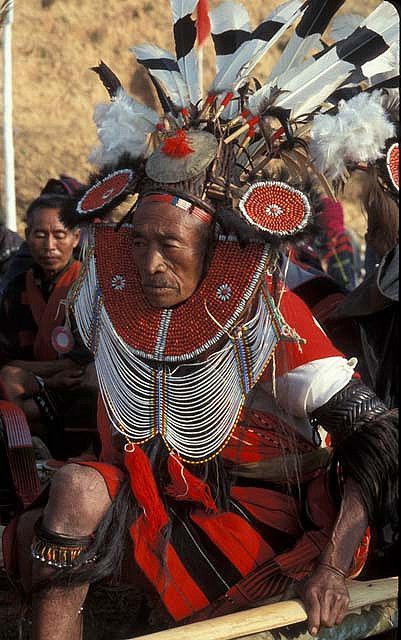



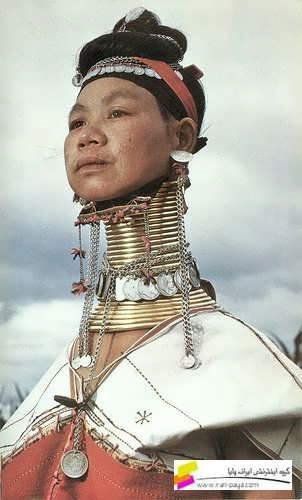
Myanmar
1. Loikaw, Myanmar by Steve Curry
4. Akha woman
5-6. Kayan people
#fashion#myanmar#myanmar fashion#kayan#kayan fashion#jewelry#body modification#southeast asia#southeast asian fashion#Akha
491 notes
·
View notes
Photo

Akha mother and daughter, Myanmar, by Sabrina Nicolazzi
#myanmar#asia#southeast asia#akha#culture#people#traditional clothing#tradition#folk#folk clothing#traditional fashion#fashion#diversity#geography
426 notes
·
View notes
Text
Photographer Documents Myanmar Tribe's Traditional Headwear
By Omar Rida
The diversified culture of Myanmar is part of the country’s unique identity. Akha tribe is located in the hill tribes area. They are known to have silver caps which differentiate them from other tribes. What amazed me is the style of decoration especially the coins which are a sign of wealth.
The coins go back to more than two centuries. France and India are the origins of some of…
View On WordPress
0 notes
Photo

Speaking of Marchesa Luisa Casati, we happen to think that this gorgeous antique Akha hat from 1950-60’s Northern Thailand that came down from our shelves for a gander would be right up her alley. Can you even imagine all of the work that went into this entirely handmade piece?! (Antique Akha hat, $450) #akha #akhahat #beadedhat #handmadehat #handmadeheadpiece #headpiece #hat #beadedheadpiece #handmade #oneofakind #unusual #interesting #northernthailand #thailand #fashion #style #styleinspiration #luisacasati #shop #nyc #unionsquare (at Beads of Paradise NYC)
#oneofakind#thailand#styleinspiration#fashion#akha#beadedheadpiece#handmade#akhahat#headpiece#shop#luisacasati#hat#style#handmadeheadpiece#unusual#handmadehat#northernthailand#unionsquare#nyc#beadedhat#interesting
0 notes
Photo

What do you do when faced with a last minute fashion event in the city while in full country mode upstate with nothing but jeans and a mumu in your carryon? And it’s a 100 degrees out? ⠀ You thrift a vintage nightgown and throw on the #Akha tribal headdress you don’t travel without, duh. Oh and wear purple lipstick on the eyelids of course. ⠀ #battleconditions ⠀ 🚨G I V E A W A Y🚨⠀ 1⃣PREORDER #PolkaDotParade: A Book About Bill Cunningham (recipient of the prestigious @Kirkus_Reviews STAR🌟) LINK IN BIO ⠀ 2⃣GET LIMITED EDITION SIGNED ARTIST PRINT FROM THE BOOK⠀ 3⃣GET 20% OFF list price⠀ ENDS 8/13⠀ First 50 responders only⠀ Book + Print ship 8/28⠀ .⠀ .⠀ .⠀ .⠀ .⠀ .⠀ #ootd #mashastyles #mashamakes #ihavethisthingwithhats #personalstyle #fblogger #whatiwore #streetstyleluxe #realoutfitgram #lotd #fashiondiaries #fashionmoment #widn #outfitgoals #vintage⠀ #artmashine #art #illustration #book #fashion #ootd #nyfw #artistsofinstagram #streetfashion #polkadotparade #fashionpassion #BillCunningham (at New-York Historical Society) https://www.instagram.com/p/BmQ7h8hAOUH/?utm_source=ig_tumblr_share&igshid=jzf48jbbz9qf
#akha#battleconditions#polkadotparade#ootd#mashastyles#mashamakes#ihavethisthingwithhats#personalstyle#fblogger#whatiwore#streetstyleluxe#realoutfitgram#lotd#fashiondiaries#fashionmoment#widn#outfitgoals#vintage#artmashine#art#illustration#book#fashion#nyfw#artistsofinstagram#streetfashion#fashionpassion#billcunningham
0 notes